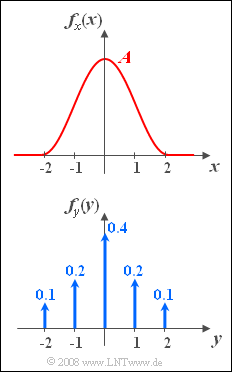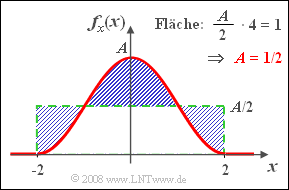Exercise 3.1: Cosine-square PDF and PDF with Dirac Functions
The graph shows the probability density functions (PDF) of two random variables $x$ and $y$.
- The PDF of the random variable $x$ in analytical form is:
- $$f_x(x)=\left\{\begin{array}{*{4}{c}}A \cdot \cos^2({\pi}/{4}\cdot x) &\rm f\ddot{u}r\hspace{0.1cm} -2\le \it x\le \rm +2, \\0 & \rm else. \\\end{array}\right.$$
- The PDF of the random variable $y$ consists of a total of five Dirac functions with the weights given in the graph.
If we consider these random variables as instantaneous values of two random signals $x(t)$ and $y(t)$, it is obvious that both signals are "amplitude limited" to the range $\pm 2$ . Values larger in absolute value do not occur.
Hints:
- The exercise belongs to the chapter Probability Density Function.
- Reference is also made to the chapter From random experiment to random variable.
- The following integral equation holds:
- $$\int \cos^{\rm 2}( ax)\, {\rm d}x=\frac{x}{2}+\frac{1}{4 a}\cdot \sin(2 ax).$$
Questions
Solution
(1) Correct are statements 1, 2, and 4:
- $x$ is continuous value.
- $y$ is discrete value $(M = 5)$.
- The PDF does not provide information about whether a random variable is discrete or continuous in time.
(2) The area under the PDF must yield $1$ .
- By simple geometric reasoning, one arrives at the result $\underline{A=0.5}$.
(3) The probability that the continuous-valued random variablee $x$ takes a fixed value $x_0$ is always negligibly small ⇒ $\underline{{\rm Pr}(x = 0) = 0}$.
- On the other hand, for the discrete value random variable $y$ holds according to the specification: ${\rm Pr}(y = 0) = 0.4$ $($weight of the Dirac function at $y = 0)$.
(4) Because of ${{\rm Pr}(x = 0) = 0}$ and PDF symmetry, we get $\underline{{\rm Pr}(x > 0) = 0.5}$.
(5) Since $y$ is a discrete random variable, the probabilities for $y = 1$ and $y = 2$ add up:
- $${\rm Pr}(y >0) = {\rm Pr}(y = 1) + {\rm Pr}( y = 2) \hspace{0.15cm}\underline {= 0.3}.$$
(6) The event $|\hspace{0.05cm} y \hspace{0.05cm} | < 1$ here is identical to $y = 0$. Thus we obtain:
- $${\rm Pr}(|\hspace{0.05cm}y\hspace{0.05cm}| < 1) = {\rm Pr}( y = 0)\hspace{0.15cm}\underline { = 0.4}.$$
(7) The probability we are looking for is equal to the integral from $-1$ to $+1$ over the PDF of the continuous random variable $x$.
- Taking into account the symmetry and the given equation, we obtain:
- $${\rm Pr}(|\hspace{0.05cm} x\hspace{0.05cm}|<1)=2 \cdot \int_{0}^{1}{1}/{2}\cdot \cos^2({\pi}/{4}\cdot x)\hspace{0.1cm}{\rm d}x={x}/{2}+{1}/{\pi}\cdot \sin({\pi}/{2}\cdot x)\Big |_{\rm 0}^{\rm 1}=\rm{1}/{2} + {1}/{\pi} \hspace{0.15cm}\underline{ \approx 0.818}.$$

